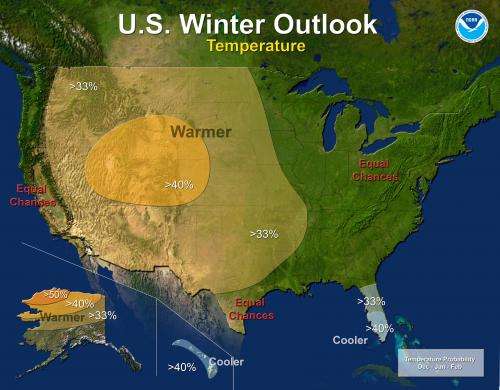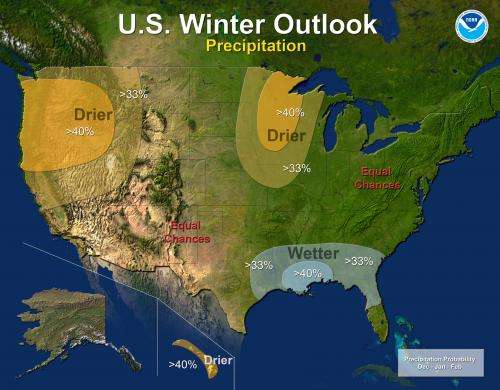Elusive El Nino challenges NOAA's 2012 US winter outlook

(Phys.org)—The western half of the continental U.S. and central and northern Alaska could be in for a warmer-than-average winter, while most of Florida might be colder-than-normal December through February, according to NOAA's annual Winter Outlook announced today from the agency's new Center for Weather and Climate Prediction in College Park, Md.
Forecasters with NOAA's Climate Prediction Center say a wavering El Niño, expected to have developed by now, makes this year's winter outlook less certain than previous years.
"This is one of the most challenging outlooks we've produced in recent years because El Niño decided not to show up as expected," said Mike Halpert, deputy director of NOAA's Climate Prediction Center. "In fact, it stalled out last month, leaving neutral conditions in place in the tropical Pacific."
When El Niño is present, warmer ocean water in the equatorial Pacific shifts the patterns of tropical rainfall that in turn influence the strength and position of the jetstream and storms over the Pacific Ocean and United States. This climate pattern gives seasonal forecasters confidence in how the U.S. winter will unfold. An El Niño watch remains in effect because there's still a window for it to emerge.

Other climate factors can influence winter weather across the country. Some of these factors, such as the North Atlantic Oscillation, a prominent climate pattern, are difficult to predict more than one to two weeks in advance. The NAO adds uncertainty to the winter outlook in the Northeast and Mid-Atlantic portions of the country.
Areas ravaged by extreme drought over the past year are unlikely to see much relief from drought conditions this winter.
In the 2012 U.S. Winter Outlook (December through February) odds favor:
- Warmer-than-average temperatures in much of Texas, northward through the Central and Northern Plains and westward across the Southwest, the Northern Rockies, and eastern Washington, Oregon and California, as well as the northern two-thirds of Alaska.
- Cooler-than-average temperatures in Hawaii and in most of Florida, excluding the panhandle.
- Drier-than-average conditions in Hawaii, the Pacific Northwest and Northern California, including Idaho, western Montana, and portions of Wyoming, Utah and most of Nevada.
- Drier-than-average conditions in the upper Midwest, including Minnesota, Wisconsin, Iowa and northern Missouri and eastern parts of North and South Dakota, Nebraska, Kansas, and western Illinois.
- Wetter-than-average conditions across the Gulf Coast states from the northern half of Florida to eastern Texas.
This seasonal outlook does not project where and when snowstorms may hit or provide total seasonal snowfall accumulations. Snow forecasts are dependent upon the strength and track of winter storms, which are generally not predictable more than a week in advance.
Provided by NOAA Headquarters














